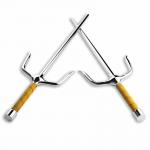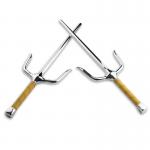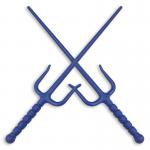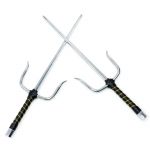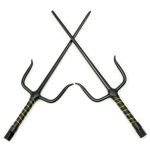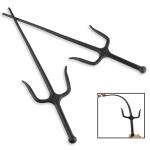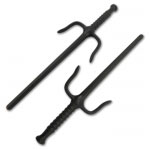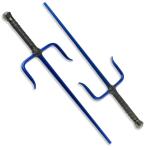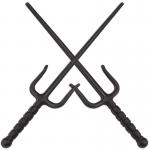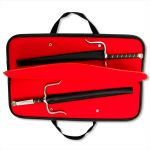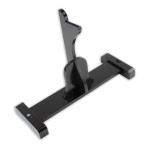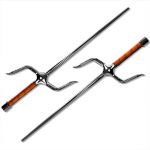Sai Weapons - Japanese Martial Arts Sais
-
From $29.95
-
From $64.95
-
From $64.95
-
$34.95
-
From $29.95
-
$34.95
For a lot of people, their first exposure to sais was through pop culture, especially Raphael from the Teenage Mutant Ninja Turtles. His aggressive style and spinning sais made a lasting impression, and let's be honest, probably inspired more than a few martial artists to pick up their first set. But real sai weapons aren't just for cartoons. They're used around the world by serious practitioners who want to sharpen their kata, improve their coordination, and deepen their understanding of traditional Japanese and Okinawan weapons.
Most sais are made from steel or aluminum, and they're designed with a weighted center, pointed tips, and curved prongs that help with trapping or redirecting attacks. They're not edged like a sword or knife, but that doesn't mean they're soft. With proper form, you can block, strike, and even disarm an opponent using nothing but a pair of sais. Some styles use longer blades for extended reach, while others prefer compact sizes for faster movement.
What Are Sai Weapons Used For?
Sai are traditionally used for blocking, striking, trapping, and redirecting attacks. While they don't have sharp edges, their pointed tips and solid metal construction can make them powerful tools in the hands of a trained martial artist. In karate and kobudo, practitioners often use them in kata (forms), self-defense drills, and weapon demonstrations. The side prongs (called yoku) are used to catch or deflect an opponent's weapon, while the center shaft (monouchi) is used for thrusting and striking.
Are Sais Considered Daggers or Swords?
Despite their appearance, sais are not classified as daggers or swords. They have no cutting edge, which sets them apart from traditional bladed weapons. Their shape is closer to a truncheon or baton, but their use in martial arts is much more dynamic. The pointed tip can be used for thrusting, but the real versatility comes from the yoku, which allow for quick redirections and weapon control. Some people call them "sai swords" or "sai knives," but those terms aren't technically accurate.
What Size Sai Should I Use?
Traditionally, the correct sai size depends on the length of your forearm. When held in your hand, the tip of the sai should extend just slightly past your elbow. This sizing helps maintain control during spins, strikes, and kata. Sais that are too long can be hard to manage, while sais that are too short may lack reach or impact during practice. If you're unsure, many martial arts schools recommend starting with a size between 18 and 21 inches depending on your arm length and experience level.
Did Ninjas Actually Use Sai Weapons?
While sai are most often linked to Okinawan martial arts, there's limited historical evidence connecting them to ninjas specifically. However, because of their compact size, ease of concealment, and ability to trap weapons, sai could have served a similar purpose in a ninja's arsenal. In modern pop culture, ninjas are often shown using sais, especially characters like Raphael from Teenage Mutant Ninja Turtles, which helps fuel the connection.
Can Sai Be Used for Self-Defense?
Sai can be used for self-defense when practiced properly, but they require training to be effective. Their shape makes them useful for blocking and redirecting attacks, and the pointed tips can deliver solid strikes. That said, because they are metal weapons, using them outside a controlled environment may not be legal in all areas.
Are Sais Allowed in Martial Arts Tournaments?
Yes, sais are commonly used in traditional weapons divisions at martial arts tournaments. Competitors often perform kata routines with sais to demonstrate control, precision, and technical skill. Just be sure to check the rules of your specific organization, as they may have size or material requirements.
Can Beginners Train With Sai Weapons?
Absolutely. Many martial arts schools introduce sai training after students have a solid foundation in empty-hand techniques. Beginners typically start with lighter sais to build coordination and control before moving on to heavier, traditional versions. With proper instruction, even new students can learn basic strikes, blocks, and kata using sai weapons.
What's the Difference Between Chrome and Black Sais?
The main difference is appearance. Chrome sais have a polished, reflective surface and are often used in demonstrations or tournaments. Black sais tend to have a more tactical or subdued look and are preferred by some practitioners for everyday training. Both perform the same function, so the choice mostly comes down to personal preference.
How Are Sais Held in the Hand?
The standard grip involves holding the handle with the thumb wrapped around one prong and the rest of the hand gripping the shaft. This allows for strong thrusts and controlled spins. For defensive moves, you can rotate the sai so that the main prong rests along your forearm to block or trap an incoming strike.
Can a Sai Really Break or Trap a Katana?
While a sai probably wouldn't break a katana blade, it can be used to trap or redirect one when handled correctly. The curved side prongs (yoku) are designed to catch or control an opponent's weapon, giving the user a chance to disarm or counterattack. In real combat, timing and technique matter more than raw strength, and skilled practitioners can use the sai's structure to deflect sword strikes or control the angle of attack. Just don't expect to snap a katana in half. Hollywood tends to exaggerate that part.







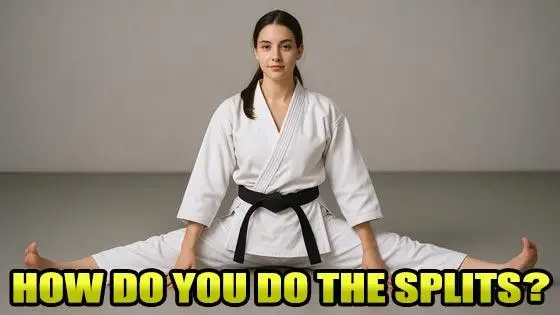

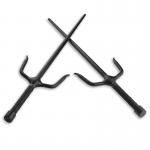

 (1)
(1)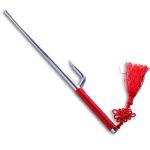
 (2)
(2)